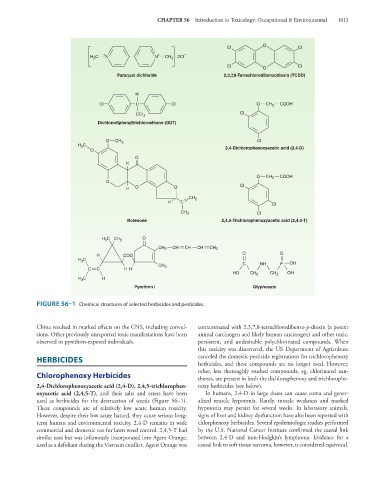Page 1027 - Basic _ Clinical Pharmacology ( PDFDrive )
P. 1027
CHAPTER 56 Introduction to Toxicology: Occupational & Environmental 1013
CI O CI
H 3 C + N N + CH 3 2CI –
CI O CI
Paraquat dichloride 2,3,7,8-Tetrachlorodibenzodioxin (TCDD)
H
CI C CI O CH 2 COOH
CCI 3 CI
Dichlorodiphenyltrichloroethane (DDT)
O CH 3 CI
H 3 C
O 2,4-Dichlorophenoxyacetic acid (2,4-D)
O
H
O CH 2 COOH
O
H O O CI
CH 2
H C CI
CH 3 CI
Rotenone 2,4,5-Trichlorophenoxyacetic acid (2,4,5-T)
H C CH 3 O
3
CH 2 CH CH CH CH 2
H COO O O
H C
3
CH 3 C NH P OH
C C H H
HO CH 2 CH 2 OH
H C H
3
Pyrethrin I Glyphosate
FIGURE 56–1 Chemical structures of selected herbicides and pesticides.
China resulted in marked effects on the CNS, including convul- contaminated with 2,3,7,8-tetrachlorodibenzo-p-dioxin (a potent
sions. Other previously unreported toxic manifestations have been animal carcinogen and likely human carcinogen) and other toxic,
observed in pyrethrin-exposed individuals. persistent, and undesirable polychlorinated compounds. When
this toxicity was discovered, the US Department of Agriculture
HERBICIDES canceled the domestic pesticide registrations for trichlorophenoxy
herbicides, and these compounds are no longer used. However,
other, less thoroughly studied compounds, eg, chlorinated xan-
Chlorophenoxy Herbicides thenes, are present in both the dichlorophenoxy and trichlorophe-
2,4-Dichlorophenoxyacetic acid (2,4-D), 2,4,5-trichlorophen- noxy herbicides (see below).
oxyacetic acid (2,4,5-T), and their salts and esters have been In humans, 2,4-D in large doses can cause coma and gener-
used as herbicides for the destruction of weeds (Figure 56–1). alized muscle hypotonia. Rarely, muscle weakness and marked
These compounds are of relatively low acute human toxicity. hypotonia may persist for several weeks. In laboratory animals,
However, despite their low acute hazard, they cause serious long- signs of liver and kidney dysfunction have also been reported with
term human and environmental toxicity. 2,4-D remains in wide chlorphenoxy herbicides. Several epidemiologic studies performed
commercial and domestic use for lawn weed control. 2,4,5-T had by the U.S. National Cancer Institute confirmed the causal link
similar uses but was infamously incorporated into Agent Orange, between 2,4-D and non-Hodgkin’s lymphoma. Evidence for a
used as a defoliant during the Vietnam conflict. Agent Orange was causal link to soft tissue sarcoma, however, is considered equivocal.

